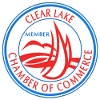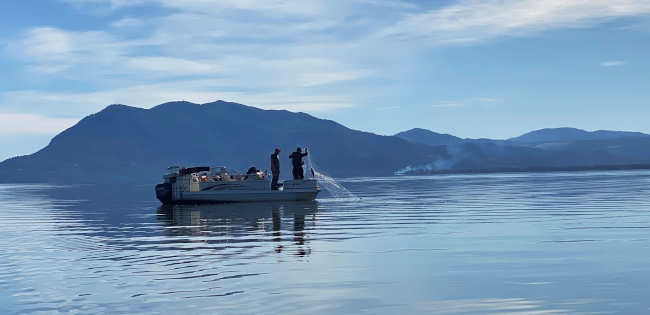
Dear Lady of the Lake,
I am wondering about the fish health of Clear Lake and what projects are being done to improve conditions for fish, especially the native Clear Lake Hitch?
Thanks And Merry Fishmas from Frank
Dear Frank,
Merry Fishmas to you too! Great question Frank and I have some fun answers for you.
In today's column I will be talking about two very important fish projects that are happening now on Clear Lake; The Kelsey Creek Fish Passage Improvement Project and the Common Carp and Goldfish removal project. The first project is aimed to improve the physical habitat for the Clear Lake Hitch in Kelsey Creek in Kelseyville and the second project is aimed to improve both lake water quality and lake habitat for hitch within the lake.
For some background information on the Clear Lake Hitch, please refer to my previous column "How About The Hitch" from Jan. 16, 2022.
The scientific name of the Clear Lake hitch is Lavinia exilicauda chi, and the native indigenous peoples of Clear Lake (the Hinthil, Gowk Xabatin, or the Pomo) refer to the fish as “chi” (pronounced CH-eye). In this article I will use hitch and chi interchangeably, as they are commonly recognized under both names.
The Kelsey Creek Fish Passage Improvement Project
The project was started by Elem Indian Colony in about 2014. In response to the inventory of fish passage barriers identified by the Hitch Adaptive Management Plan developed by the local Tribes, Elem proposed a project to US Fish and Wildlife Service (FWS) to remove the non-permitted and ineffective fish ladder near Main Street Bridge in Downtown Kelseyville.
Elem received a USFWS Tribal Wildlife Grant and hired consultants to develop the project. In 2020, the Big Valley Band of Pomo Indians (Big Valley) acquired additional funding to complete the project design and conduct the environmental review through CEQA (California Environmental Quality Act).
The project site is located directly downstream from the Main Street Bridge in downtown Kelseyville. The project was initiated to create an improved design to include special attention to the steep drop of the concrete grade control structure that prevents hitch from passing the moving up river during spawning season.
This would be accomplished through demolition and removal of the existing fish ladder and associated infrastructure downstream of the grade control structure and construction of a new reduced slope system in the same area. The project would still provide protection for the Main Street Bridge.
The current fish ladder, located on the east side of the creek, adjacent to the bridge, was installed many years ago by a group of well-meaning locals. The fish ladder was an attempt to reduce the stream velocity enough so the hitch could, step-by-step, make it upstream without having to jump over the steep concrete grade control structure at the bridge footings.
The velocity (speed) of the water in Kelsey Creek is unnaturally high because of previous gravel mining operations in the creek, and the channelizing of the creek in previous decades. Kelsey Creek, like most creeks in Lake County, originally meandered and flooded into surrounding lowland areas, called flood plains. Development, mining, and channelizing forces the creek flow through a more restrictive pathway, which increases velocity of the stream, especially during high flow storm and rain events.
Changes to natural flows and movements of creeks create other conditions such as erosion and further risk of flooding. The current fish ladder was not permitted by the state, does not address erosion, flooding, and does not actually slow down the velocity to allow hitch to pass.

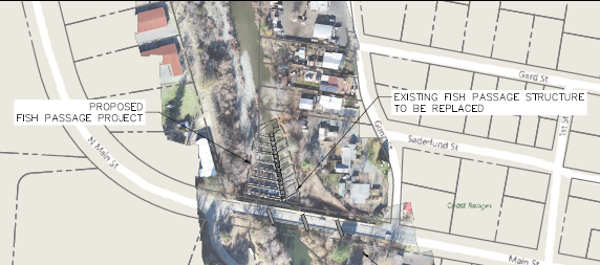
To any casual observer watching the chi try to navigate the passage in the spring, can easily see that the current ladder and drop are preventing the chi from moving further upstream. Chi are not enthusiastic or capable jumpers like salmon; they can’t physically move past barriers that are too tall or create too high velocity flows.
In addition to any new design for the benefit of the hitch, the new design should also prevent erosion downstream, limit flood potential to local area, and protect the footings of the Main street Bridge.
The proposed design finalized by the project will accomplish all of these goals.
Construction of a project of this size is very expensive, but thanks to the hard work of Big Valley, funds have been sourced and secured from several avenues, including the CDFW Restoration Grants (Prop 1), Caltrans Mitigation Funds, and Blue Ribbon Committee for the Rehabilitation of Clear Lake.
The new proposed design, called step-pool, mimics the natural form of the creek. The design includes a series of small steps, which are accessible by the hitch. The structure consists of a boulder-weir, welded together, which will withstand the strong velocity that sometimes occurs in the creek. This design will maintain stream form and function, protect the bridge footings, while allowing hitch passage access further upstream into several more miles of high-quality habitat for spawning.
As I described in my column last year about the hitch, this species is in peril and at close risk of becoming extinct, so any project that can improve habitat and increase chance of spawning survival, such as the Kelsey Creek Fish Passage Improvement Project, is extremely important and needs to be completed. Additionally, this project is another example of how local Tribes are taking a multi-pronged approach to protecting the native species of this area.
Next steps and barriers to completion
Big Valley, with consultants at FlowWest, have been able to secure funds for implementation and have acquired all the state, federal, and local permits, including a majority of CEQA and USACE approval. The project is literally ready to break ground!
However, access to the site is being hindered by a single landowner who is denying access to the stream area that is needed to begin the construction. Hopefully the landowners preventing progress on this project will acquiesce soon so this project can go forward.
Once completed this project will provide a huge improvement to hitch habitat in Kelsey Creek and will go a long way in preventing extinction of this culturally important and valuable Clear Lake fish species.
If you would like to learn more, or see how you can support Big Valley with this project, please contact Sarah Ryan at This email address is being protected from spambots. You need JavaScript enabled to view it..
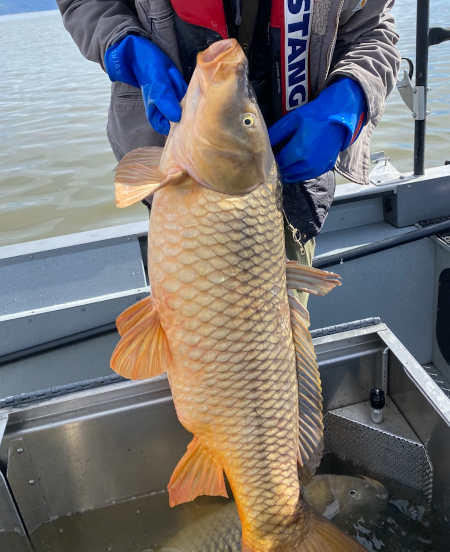
Common Carp and Goldfish Tagging and Removal Project
This project is being led by Robinson Rancheria with partners from CDFW and WSB engineering Fisheries division.
WSB Fisheries staff have been successfully removing invasive carp from other water bodies across the nation for years.
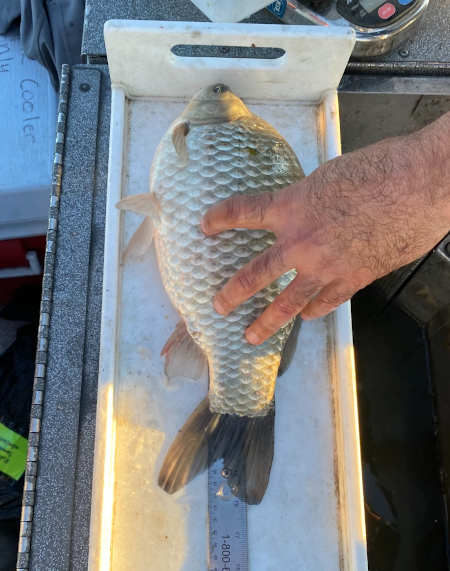
Why are carp a problem?
To understand why carp are a problem, you have to know some background and life history characteristics about the species.
Common carp (Cyprinus carpio) are non-native to Clear Lake and California. Carp are generalists, and actually do pretty well in turbid, cloudy eutrophic (nutrient-rich and green) lakes and streams. They can tolerate very cold (4 degree C) and very warm waters (30 degree C) and are also very tolerant of low oxygen levels (1 - 3 ppm).
Most fish are not tolerant of these conditions, so when conditions become stressful, such as during a drought, with high temps and low oxygen levels, most other species can struggle to survive while the carp will do just fine.
Carp females lay 500 eggs at a time and can lay between 50,000 and 2,000,000 in a single season, and carp can comfortably live up to 15 years. On average, carp can grow to more than 2 feet in length and weight over 10 pounds. However, carp caught from Clear Lake during Robinson Rancheria’s project were on average longer and heavier then these averages described in the literature.
You can learn more about the Common Carp at the UCD Clear Lake Aquatic website.
In Clear Lake, common carp have been thriving, and have grown to very high population levels, competing with hitch, bass, crappie, and other species for food and space, in the shallow zones along the shoreline of the lake.
Most importantly, carp consume large quantities of food, mostly green algae and aquatic plants, and everything they eat comes out the other end as nutrient-packed waste. All that fish excrement is being added to the Clear Lake ecosystem as algae and cyanobacteria food.
Robinson Carp removal project
Part of the long-term plans to improve Clear Lake water quality, and to improve shoreline hitch habitat, includes addressing the Clear Lake carp problem.
Robinson Rancheria’s fishery division is tackling this problem head-on, with a stratified plan to locate, mass-catch, remove, monitor, and sustainably manage the carp population in Clear Lake. Phase 1 of this project is almost completed, but really will be ongoing throughout the duration of the project.
A large part of phase 1 included the locating of carp, some preliminary tagging and monitoring, and some analysis to identify exactly how much impact the carp are having on the lake’s ecosystem and nutrient budget.
According to preliminary analysis completed by WSB Engineers, the expert carp removal consultants working with Robinson Rancheria and CDFW on this project, there are about 172 pounds of carp per acre of Clear Lake, and at about 44,000 acres this means there is about 7.6 million pounds of carp swimming around in the lake.
Goldfish are similar in that there are about 65 lbs per acre, or 2.8 million pounds of goldfish in our lake for a total of 10.4 million pounds of large-scaled, slimy, carp and goldfish in Clear Lake. Both of those fish are eating food that hitch and bass need and are creating large quantities of nutrients that are fueling the algae and cyanobacteria blooms.
Robinson Rancheria and consultants also identified that for Clear Lake, 89 pounds per acre of these fish is considered the “tipping point,” where the ecosystem is maxed out and the ecology is being disrupted.
Additionally, the carp are also major contributors to internal loading of phosphorus at a calculated load of 16,135 Kg per year. This is the amount of phosphorus the carp are releasing into the water column from the lake bottom sediments.
This process, called bioturbation, occurs as the fish root around in the bottom sediments, causing plumes of phosphorus-rich soils to flow into the water column and also when they yank, pull-up and eat aquatic plants, and eventually contribute waste into the system.
According to the State of California’s Clear Lake TMDL program, phosphorus inputs from the county of Lake, the cities of Clearlake, and Lakeport urban areas are only allowable up to 2,000 kg per year. Therefore, the carp in Clear Lake alone are contributing 8X more phosphorus to the lake ecosystem than all the urban areas around the lake are contributing.
This is a pretty significant finding and when Robinson Rancheria’s project is successful, the water quality improvements to the lake will be quite noticeable.
This project is currently in phase 2, of about 7 phases. The first phase was the tagging and tracking of common carp and goldfish in Clear Lake, to identify where the groups of carp and goldfish are congregating in the lake so that they can be systematically collected and removed, which is the main portion of several later phases. Phase 2 will include conducting a feasibility study to identify the best method for removing the target amount of carp and goldfish biomass, and funds, materials and effort to sustain the program.
The other phases will include the maintenance portion of the project. Population monitoring and regular removal to maintain a low population in the lake will be the most important part of this project, so that the population doesn’t rebound and get to the current numbers where they impact water quality and native fish populations.
About now, you might be thinking, “Lady of the Lake, what are they planning to do with ALL that carp biomass that will be removed?” And that’s a great question!
Not only has WSB been successful in removing carp from other lake systems, but they also have identified markets to sell the collected carp, whether for human or pet food, or fertilizer. Having a safe, reliable place to send harvested carp has been a barrier to past removal efforts in the lake. This component hasn’t been explicitly identified as of yet for Robinson Rancheria’s project, but work has started and will probably involve some creative solutions.
Commercial harvest of carp in the past has been relatively successful in managing carp in Clear Lake, but there just isn’t a local demand for carp as there are for other fisheries, so maintaining low numbers of the species using that method did not prove sustainable.
While this project is still in its first stages, it’s extremely promising and has been fully funded through phase 2, with phase 2 funds having been approved by the Blue Ribbon Committee for the Rehabilitation of Clear Lake.
If you want more information or want to support this project, you can contact the manager at Robinson Rancheria Water Resources Division/interim Environmental Director Karola Kennedy, This email address is being protected from spambots. You need JavaScript enabled to view it., or the project’s fisheries biologist, Luis Santana at This email address is being protected from spambots. You need JavaScript enabled to view it..
Sincerely,
Lady of the Lake
Angela De Palma-Dow is a limnologist (limnology = study of fresh inland waters) who lives and works in Lake County. Born in Northern California, she has a Master of Science from Michigan State University. She is a Certified Lake Manager from the North American Lake Management Society, or NALMS, and she is the current president/chair of the California chapter of the Society for Freshwater Science. She can be reached at This email address is being protected from spambots. You need JavaScript enabled to view it..
The Lady of the Lake would like to acknowledge and thank Karola Kennedy and Luis Santana from Robinson Rancheria, Sarah Ryan from Big Valley Band of Pomo Indians, and Anthony Falzone from FlowWest for assistance and approval in completing this column.

 How to resolve AdBlock issue?
How to resolve AdBlock issue? 



